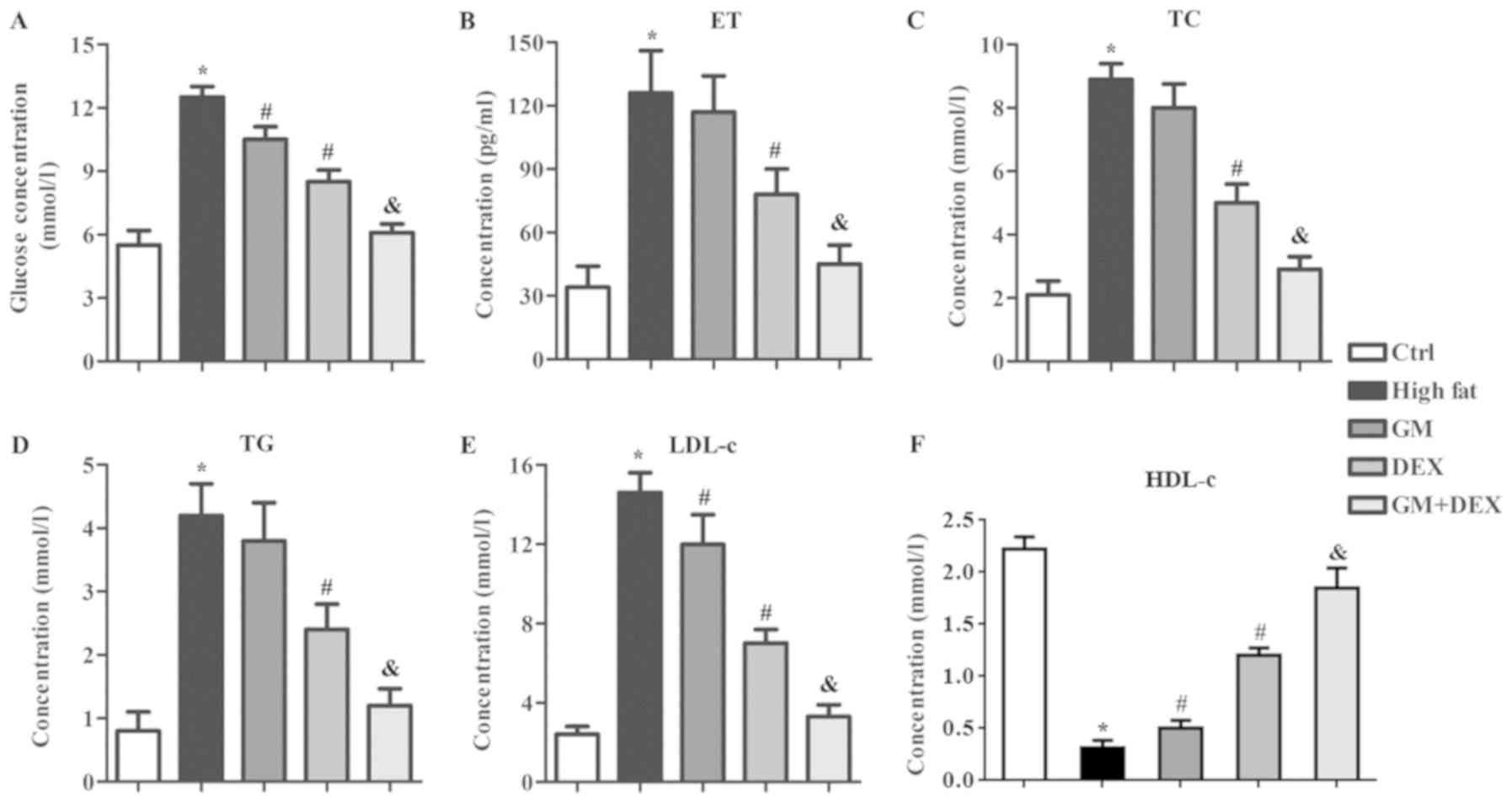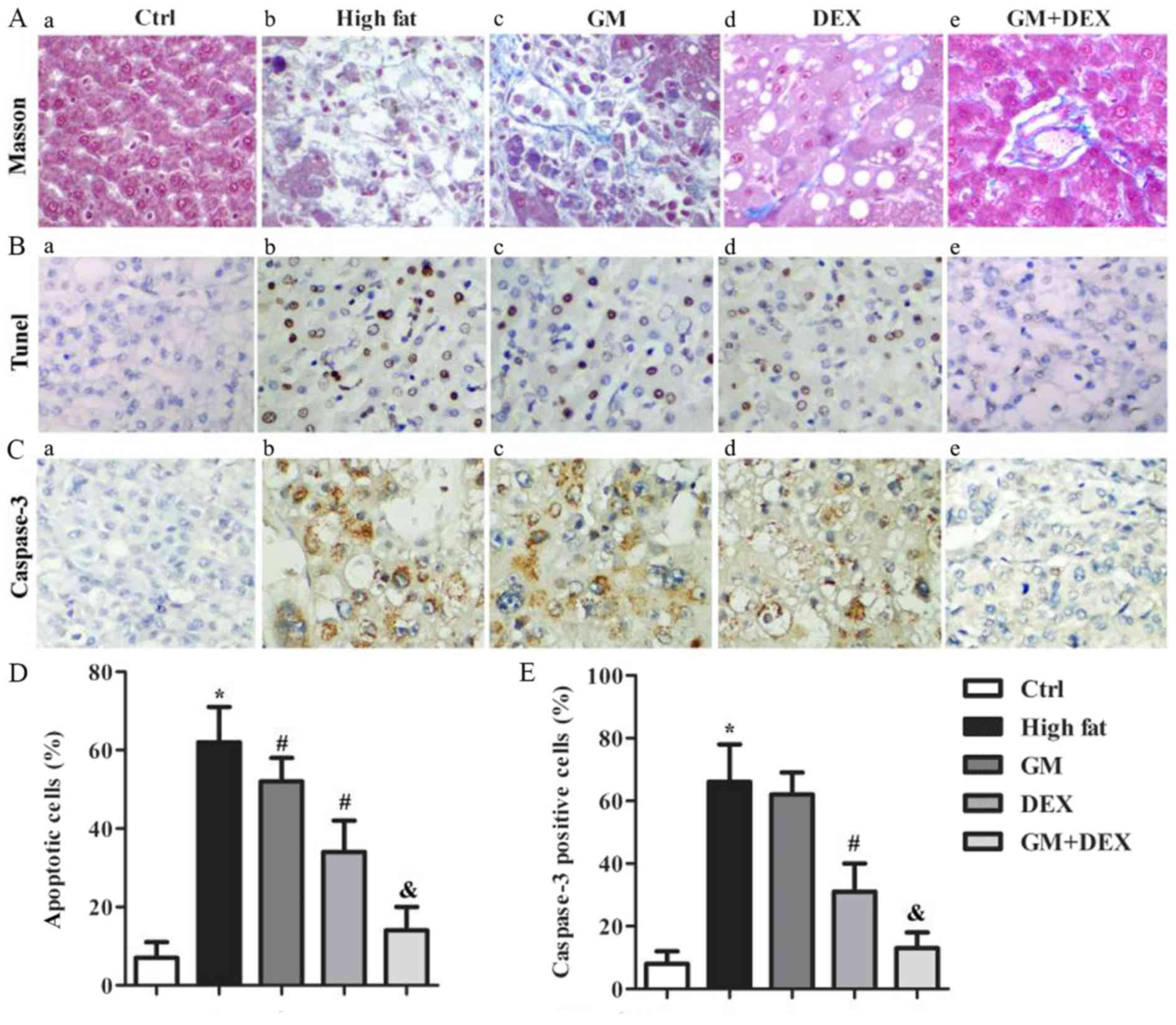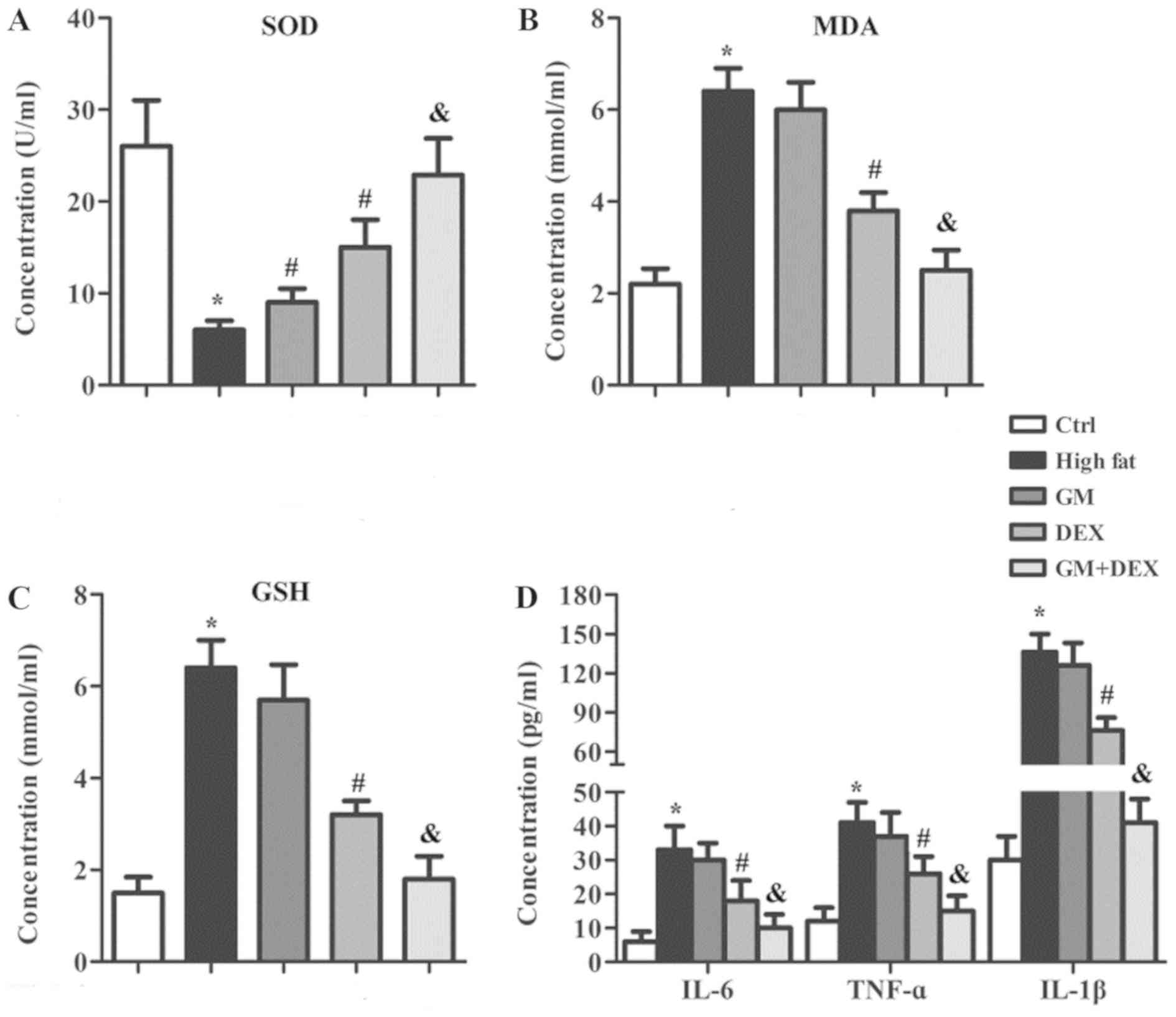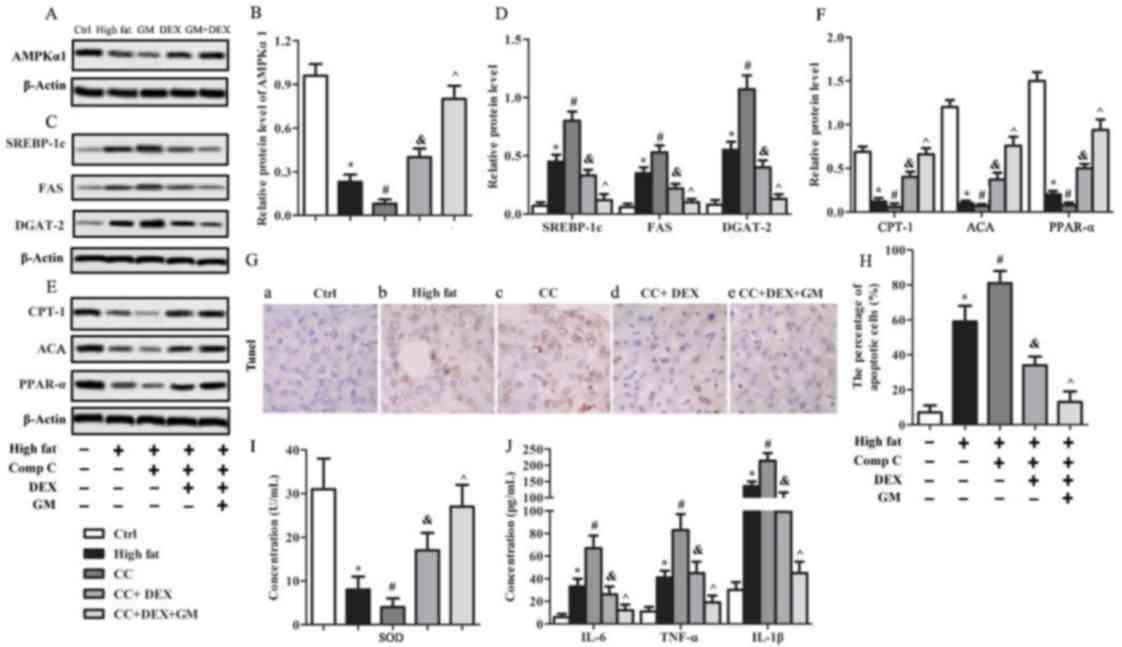|
1
|
Basciano H, Federico L and Adeli K:
Fructose, insulin resistance, and metabolic dyslipidemia. Nutr
Metab (Lond). 2:52005. View Article : Google Scholar : PubMed/NCBI
|
|
2
|
Zimmet PZ, Magliano DJ, Herman WH and Shaw
JE: Diabetes: A 21st century challenge. Lancet Diabetes Endocrinol.
2:56–64. 2014. View Article : Google Scholar : PubMed/NCBI
|
|
3
|
Musso G, Gambino R and Cassader M:
Non-alcoholic fatty liver disease from pathogenesis to management:
An update. Obes Rev. 11:430–445. 2010. View Article : Google Scholar : PubMed/NCBI
|
|
4
|
Rivera CA: Risk factors and mechanisms of
non-alcoholic steatohepatitis. Pathophysiology. 15:109–114. 2008.
View Article : Google Scholar : PubMed/NCBI
|
|
5
|
Qiang G, Zhang L, Yang X, Xuan Q, Shi L,
Zhang H, Chen B, Li X, Zu M, Zhou D, et al: Effect of valsartan on
the pathological progression of hepatic fibrosis in rats with type
2 diabetes. Eur J Pharmacol. 685:156–164. 2012. View Article : Google Scholar : PubMed/NCBI
|
|
6
|
Lo L, McLennan SV, Williams PF, Bonner J,
Chowdhury S, McCaughan GW, Gorrell MD, Yue DK and Twigg SM:
Diabetes is a progression factor for hepatic fibrosis in a high fat
fed mouse obesity model of non-alcoholic steatohepatitis. J
Hepatol. 55:435–444. 2011. View Article : Google Scholar : PubMed/NCBI
|
|
7
|
Brownlee M: Biochemistry and molecular
cell biology of diabetic complications. Nature. 414:813–820. 2001.
View Article : Google Scholar : PubMed/NCBI
|
|
8
|
Sada K, Nishikawa T, Kukidome D, Yoshinaga
T, Kajihara N, Sonoda K, Senokuchi T, Motoshima H, Matsumura T and
Araki E: Hyperglycemia induces cellular hypoxia through production
of mitochondrial ROS followed by suppression of aquaporin-1. PLoS
One. 11:e01586192016. View Article : Google Scholar : PubMed/NCBI
|
|
9
|
Maritim AC, Sanders RA and Watkins JB III:
Diabetes, oxidative stress, and antioxidants: A review. J Biochem
Mol Toxicol. 17:24–38. 2003. View Article : Google Scholar : PubMed/NCBI
|
|
10
|
Dubey R, Minj P, Malik N, Sardesai DM,
Kulkarni SH, Acharya JD, Bhavesh NS, Sharma S and Kumar A:
Recombinant human islet amyloid polypeptide forms shorter fibrils
and mediates β-cell apoptosis via generation of oxidative stress.
Biochem J. 474:3915–3934. 2017. View Article : Google Scholar : PubMed/NCBI
|
|
11
|
Ige AO and Adewoye EO: Oral magnesium
treatment reduces anemia and levels of inflammatory markers in
experimental diabetes. J Diet Suppl. 14:76–88. 2017. View Article : Google Scholar : PubMed/NCBI
|
|
12
|
Attie AD and Scherer PE: Adipocyte
metabolism and obesity. J Lipid Res. 50 (Suppl):S395–S399. 2009.
View Article : Google Scholar : PubMed/NCBI
|
|
13
|
Chen L, Chen R, Wang H and Liang F:
Mechanisms linking inflammation to insulin resistance. Int J
Endocrinol. 2015:5084092015. View Article : Google Scholar : PubMed/NCBI
|
|
14
|
Feldman EL, Nave KA, Jensen TS and Bennett
DLH: New horizons in diabetic neuropathy: Mechanisms,
bioenergetics, and pain. Neuron. 93:1296–1313. 2017. View Article : Google Scholar : PubMed/NCBI
|
|
15
|
Jaakola ML, Salonen M, Lehtinen R and
Scheinin H: The analgesic action of dexmedetomidine-a novel alpha
2-adrenoceptor agonist-in healthy volunteers. Pain. 46:281–285.
1991. View Article : Google Scholar : PubMed/NCBI
|
|
16
|
Kip G, Çelik A, Bilge M, Alkan M, Kiraz
HA, Özer A, Şıvgın V, Erdem Ö, Arslan M and Kavutçu M:
Dexmedetomidine protects from post-myocardial ischaemia reperfusion
lung damage in diabetic rats. Libyan J Med. 10:278282015.
View Article : Google Scholar
|
|
17
|
Zeng X, Wang H, Xing X, Wang Q and Li W:
Dexmedetomidine protects against transient global cerebral
ischemia/reperfusion induced oxidative stress and inflammation in
diabetic rats. PLoS One. 11:e01516202016. View Article : Google Scholar : PubMed/NCBI
|
|
18
|
Ma XD, Li BP, Wang DL and Yang WS:
Postoperative benefits of dexmedetomidine combined with
flurbiprofen axetil after thyroid surgery. Exp Ther Med.
14:2148–2152. 2017. View Article : Google Scholar : PubMed/NCBI
|
|
19
|
Qian XL, Zhang W, Liu MZ, Zhou YB, Zhang
JM, Han L, Peng YM, Jiang JH and Wang QD: Dexmedetomidine improves
early postoperative cognitive dysfunction in aged mice. Eur J
Pharmacol. 746:206–212. 2015. View Article : Google Scholar : PubMed/NCBI
|
|
20
|
Wu J, Feng Y, Han C, Huang W, Shen Z, Yang
M, Chen W and Ye L: Germacrone derivatives: Synthesis, biological
activity, molecular docking studies and molecular dynamics
simulations. Oncotarget. 8:15149–15158. 2017.PubMed/NCBI
|
|
21
|
Xie XH, Zhao H, Hu YY and Gu XD:
Germacrone reverses Adriamycin resistance through cell apoptosis in
multidrug-resistant breast cancer cells. Exp Ther Med. 8:1611–1615.
2014. View Article : Google Scholar : PubMed/NCBI
|
|
22
|
Chen QF, Wang G, Tang LQ, Yu XW, Li ZF and
Yang XF: Effect of germacrone in alleviating HUVECs damaged by
H2O2-induced oxidative stress. Zhongguo Zhong
Yao Za Zhi. 42:3564–3571. 2017.(In Chinese). PubMed/NCBI
|
|
23
|
Guo YR and Choung SY: Germacrone
attenuates hyperlipidemia and improves lipid metabolism in high-fat
diet-induced obese C57BL/6J mice. J Med Food. 20:46–55. 2017.
View Article : Google Scholar : PubMed/NCBI
|
|
24
|
Seo E, Park EJ, Joe Y, Kang S, Kim MS,
Hong SH, Park MK, Kim DK, Koh H and Lee HJ: Overexpression of
AMPKalpha1 ameliorates fatty liver in hyperlipidemic diabetic rats.
Korean J Physiol Pharmacol. 13:449–454. 2009. View Article : Google Scholar : PubMed/NCBI
|
|
25
|
Committee for the Update of the Guide for
the Care and Use of Laboratory Animals, . Guide for the care and
use of laboratory animals (Eighth edition)The National Academies
Press; Washington, D.C.: 2011
|
|
26
|
Li J, Feng J, Wei H, Liu Q, Yang T, Hou S,
Zhao Y, Zhang B and Yang C: The aqueous extract of Gynura
divaricata (L.) DC. improves glucose and lipid metabolism and
ameliorates type 2 diabetes mellitus. Evid Based Complement
Alternat Med. 2018:86862972018.PubMed/NCBI
|
|
27
|
Brunt EM: Nonalcoholic steatohepatitis:
Definition and pathology. Semin Liver Dis. 21:3–16. 2001.
View Article : Google Scholar : PubMed/NCBI
|
|
28
|
Yagi S, Doorschodt BM, Afify M, Klinge U,
Kobayashi E, Uemoto S and Tolba RH: Improved preservation and
microcirculation with POLYSOL after partial liver transplantation
in rats. J Surg Res. 167:e375–e383. 2011. View Article : Google Scholar : PubMed/NCBI
|
|
29
|
Elmore S: Apoptosis: A review of
programmed cell death. Toxicol Pathol. 35:495–516. 2007. View Article : Google Scholar : PubMed/NCBI
|
|
30
|
Michurina SV, Ischenko IY, Arkhipov SA,
Klimontov VV, Cherepanova MA, Korolev MA, Rachkovskaya LN,
Zav'yalov EL and Konenkov VI: Melatonin-aluminum
oxide-polymethylsiloxane complex on apoptosis of liver cells in a
Model of obesity and type 2 diabetes mellitus. Bull Exp Biol Med.
164:165–169. 2017. View Article : Google Scholar : PubMed/NCBI
|
|
31
|
Lee SY, Ku HC, Kuo YH, Chiu HL and Su MJ:
Pyrrolidinyl caffeamide against ischemia/reperfusion injury in
cardiomyocytes through AMPK/AKT pathways. J Biomed Sci. 22:182015.
View Article : Google Scholar : PubMed/NCBI
|
|
32
|
Zhang C, Huang Z, Gu J, Yan X, Lu X, Zhou
S, Wang S, Shao M, Zhang F, Cheng P, et al: Fibroblast growth
factor 21 protects the heart from apoptosis in a diabetic mouse
model via extracellular signal-regulated kinase 1/2-dependent
signalling pathway. Diabetologia. 58:1937–1948. 2015. View Article : Google Scholar : PubMed/NCBI
|
|
33
|
Yang H, Feng A, Lin S, Yu L, Lin X, Yan X,
Lu X and Zhang C: Fibroblast growth factor-21 prevents diabetic
cardiomyopathy via AMPK-mediated antioxidation and lipid-lowering
effects in the heart. Cell Death Dis. 9:2272018. View Article : Google Scholar : PubMed/NCBI
|
|
34
|
Yang P, Pei Q, Yu T, Chang Q, Wang D, Gao
M, Zhang X and Liu Y: Compromised wound healing in ischemic type 2
diabetic rats. PLoS One. 11:e01520682016. View Article : Google Scholar : PubMed/NCBI
|
|
35
|
Wang RR, Chen XY, Liao HL, Wan L, Li JM,
Chen LL, Chen XF and Chen GR: The relationship between the
expression of NF-kB, TGFbeta1, FN and hepatic fibrosis in diabetic
rats. Zhonghua Gan Zang Bing Za Zhi. 18:194–198. 2010.(In Chinese).
PubMed/NCBI
|
|
36
|
Kotronen A and Yki-Järvinen H: Fatty
liver: A novel component of the metabolic syndrome. Arterioscler
Thromb Vasc Biol. 28:27–38. 2008. View Article : Google Scholar : PubMed/NCBI
|
|
37
|
Cusi K: Nonalcoholic fatty liver disease
in type 2 diabetes mellitus. Curr Opin Endocrinol Diabetes Obes.
16:141–149. 2009. View Article : Google Scholar : PubMed/NCBI
|
|
38
|
Zhou H, Fang C, Zhang L, Deng Y, Wang M
and Meng F: Fasudil hydrochloride hydrate, a Rho-kinase inhibitor,
ameliorates hepatic fibrosis in rats with type 2 diabetes. Chin Med
J (Engl). 127:225–231. 2014.PubMed/NCBI
|
|
39
|
Williams KH, Vieira De Ribeiro AJ, Prakoso
E, Veillard AS, Shackel NA, Brooks B, Bu Y, Cavanagh E, Raleigh J,
McLennan SV, et al: Circulating dipeptidyl peptidase-4 activity
correlates with measures of hepatocyte apoptosis and fibrosis in
non-alcoholic fatty liver disease in type 2 diabetes mellitus and
obesity: A dual cohort cross-sectional study. J Diabetes.
7:809–819. 2015. View Article : Google Scholar : PubMed/NCBI
|
|
40
|
Tourigny A, Charbonneau F, Xing P, Boukrab
R, Rousseau G, St-Arnaud R and Brezniceanu ML: CYP24A1 exacerbated
activity during diabetes contributes to kidney tubular apoptosis
via caspase-3 increased expression and activation. PLoS One.
7:e486522012. View Article : Google Scholar : PubMed/NCBI
|
|
41
|
Samikkannu T, Thomas JJ, Bhat GJ, Wittman
V and Thekkumkara TJ: Acute effect of high glucose on long-term
cell growth: A role for transient glucose increase in proximal
tubule cell injury. Am J Physiol Renal Physiol. 291:F162–F175.
2006. View Article : Google Scholar : PubMed/NCBI
|
|
42
|
Das M and Manna K: Chalcone scaffold in
anticancer armamentarium: A molecular insight. J Toxicol.
2016:76510472016. View Article : Google Scholar : PubMed/NCBI
|
|
43
|
Romagnoli R, Baraldi PG, Cruz-Lopez O,
Lopez Cara C, Carrion MD, Brancale A, Hamel E, Chen L, Bortolozzi
R, Basso G and Viola G: Synthesis and antitumor activity of
1,5-disubstituted 1,2,4-triazoles as cis-restricted combretastatin
analogues. J Med Chem. 53:4248–4258. 2010. View Article : Google Scholar : PubMed/NCBI
|
|
44
|
Bonner C, Bacon S, Concannon CG, Rizvi SR,
Baquié M, Farrelly AM, Kilbride SM, Dussmann H, Ward MW, Boulanger
CM, et al: INS-1 cells undergoing caspase-dependent apoptosis
enhance the regenerative capacity of neighboring cells. Diabetes.
59:2799–2808. 2010. View Article : Google Scholar : PubMed/NCBI
|
|
45
|
Ahmed FF, Abd El-Hafeez AA, Abbas SH,
Abdelhamid D and Abdel-Aziz M: New 1,2,4-triazole-Chalcone hybrids
induce Caspase-3 dependent apoptosis in A549 human lung
adenocarcinoma cells. Eur J Med Chem. 151:705–722. 2018. View Article : Google Scholar : PubMed/NCBI
|
|
46
|
Gerber PA and Rutter GA: The role of
oxidative stress and hypoxia in pancreatic beta-cell dysfunction in
diabetes mellitus. Antioxid Redox Signal. 26:501–518. 2017.
View Article : Google Scholar : PubMed/NCBI
|
|
47
|
Styskal J, Van Remmen H, Richardson A and
Salmon AB: Oxidative stress and diabetes: What can we learn about
insulin resistance from antioxidant mutant mouse models? Free Radic
Biol Med. 52:46–58. 2012. View Article : Google Scholar : PubMed/NCBI
|
|
48
|
Chen H, Yu M, Li M, Zhao R, Zhu Q, Zhou W,
Lu M, Lu Y, Zheng T, Jiang J, et al: Polymorphic variations in
manganese superoxide dismutase (MnSOD), glutathione peroxidase-1
(GPX1), and catalase (CAT) contribute to elevated plasma
triglyceride levels in Chinese patients with type 2 diabetes or
diabetic cardiovascular disease. Mol Cell Biochem. 363:85–91. 2012.
View Article : Google Scholar : PubMed/NCBI
|
|
49
|
Earle KA, Zitouni K, Pepe J, Karaflou M
and Godbold J Jr: Modulation of endogenous antioxidant defense and
the progression of kidney disease in multi-heritage groups of
patients with type 2 diabetes: PRospective EValuation of Early
Nephropathy and its Treatment (PREVENT). J Transl Med. 14:2342016.
View Article : Google Scholar : PubMed/NCBI
|
|
50
|
Mohammedi K, Patente TA, Bellili-Muñoz N,
Driss F, Monteiro MB, Roussel R, Pavin EJ, Seta N, Fumeron F,
Azevedo MJ, et al: Catalase activity, allelic variations in the
catalase gene and risk of kidney complications in patients with
type 1 diabetes. Diabetologia. 56:2733–2742. 2013. View Article : Google Scholar : PubMed/NCBI
|
|
51
|
Boden G, She P, Mozzoli M, Cheung P,
Gumireddy K, Reddy P, Xiang X, Luo Z and Ruderman N: Free fatty
acids produce insulin resistance and activate the proinflammatory
nuclear factor-kappaB pathway in rat liver. Diabetes. 54:3458–3465.
2005. View Article : Google Scholar : PubMed/NCBI
|
|
52
|
Das A and Mukhopadhyay S: The evil axis of
obesity, inflammation and type-2 diabetes. Endocr Metab Immune
Disord Drug Targets. 11:23–31. 2011. View Article : Google Scholar : PubMed/NCBI
|
|
53
|
Goldfine AB, Fonseca V and Shoelson SE:
Therapeutic approaches to target inflammation in type 2 diabetes.
Clin Chem. 57:162–167. 2011. View Article : Google Scholar : PubMed/NCBI
|
|
54
|
Zhang C, Lu X, Tan Y, Li B, Miao X, Jin L,
Shi X, Zhang X, Miao L, Li X and Cai L: Diabetes-induced hepatic
pathogenic damage, inflammation, oxidative stress, and insulin
resistance was exacerbated in zinc deficient mouse model. PLoS One.
7:e492572012. View Article : Google Scholar : PubMed/NCBI
|
|
55
|
Pan HY, Guo L and Li Q: Changes of serum
omentin-1 levels in normal subjects and in patients with impaired
glucose regulation and with newly diagnosed and untreated type 2
diabetes. Diabetes Res Clin Pract. 88:29–33. 2010. View Article : Google Scholar : PubMed/NCBI
|
|
56
|
Selvaraju V, Joshi M, Suresh S, Sanchez
JA, Maulik N and Maulik G: Diabetes, oxidative stress, molecular
mechanism, and cardiovascular disease-an overview. Toxicol Mech
Methods. 22:330–335. 2012. View Article : Google Scholar : PubMed/NCBI
|
|
57
|
Sukriti S, Tauseef M, Yazbeck P and Mehta
D: Mechanisms regulating endothelial permeability. Pulm Circ.
4:535–551. 2014. View
Article : Google Scholar : PubMed/NCBI
|
|
58
|
Ma X, Zhang J, Deng R, Ding S, Gu N and
Guo X: Synergistic effect of smoking with genetic variants in the
AMPKalpha1 gene on the risk of coronary artery disease in type 2
diabetes. Diabetes Metab Res Rev. 30:483–488. 2014. View Article : Google Scholar : PubMed/NCBI
|















